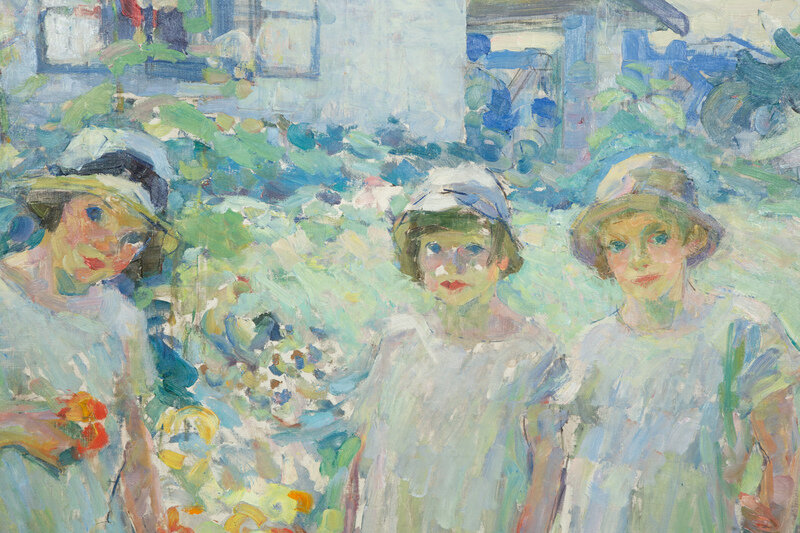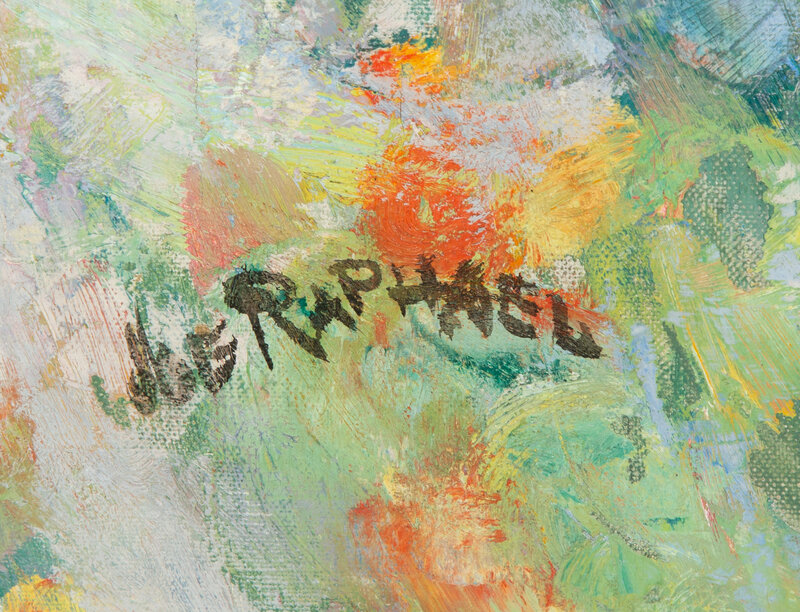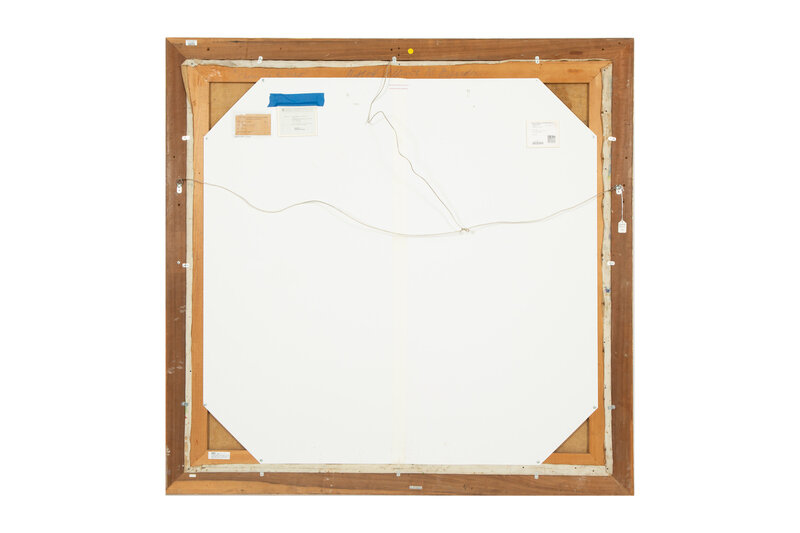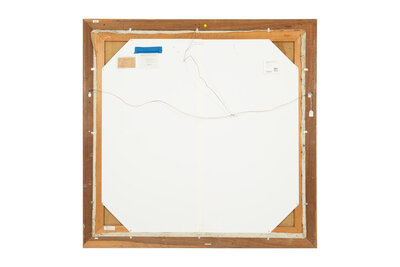Joseph Raphael
(American, 1869-1950)
Children of the Artist, c. 1920-24
Sale 1296 - A Lasting Legacy: The Estate of Michael Mennello
Feb 21, 2024
10:00AM ET
Live / Palm Beach
Estimate
$40,000 -
$60,000
Item was unsold
Lot Description
Joseph Raphael
(American, 1869-1950)
Children of the Artist, c. 1920-24
oil on canvas
signed Joe Raphael (lower left); titled and inscribed (on the stretcher)
57 3/4 x 59 1/4 inches.
The present lot is #P-316 in the Joseph Raphael Catalogue Raisonné (unpublished), compiled by Dr. Phyllis Hattis.
Provenance:
Albert M. Bender, San Francisco, California, prior to 1926
Ex. coll. California Palace of the Legion of Honor, San Francisco, California, gift from the above
An unusually large work for Joseph Raphael, Children of the Artist, c. 1920-24, captures the unique individuality of the three girls, likely his youngest daughters, Johanna (Joky) with blue eyes and brown hair, at left, and the middle sisters, Elizabeth (Liesbeth) and Marie-Jeanne (Dany), at the right. Their white dresses appear to shimmer in the sun, as they gaze out at the viewer inquisitively underneath the short brims of their stylish cloche hats. The surrounding garden in which the children stand is described in brilliant hues of blue, yellow, and red, applied with lively, broad brushstrokes that dance across the canvas. The dynamic surface and clear, high key colors reveal the artist as a foremost exponent of pure French Impressionism.
A native of San Francisco, Raphael found his calling as an artist in his early twenties after enrolling at the California School of Design (now the San Francisco Art Institute), where he studied under Arthur Mathews and Douglas Tilden. Like many of his artist peers, his formative decades abroad began at the Académie Julian in Paris in 1903 under Jean-Paul Laurens. It was here that he fell in with several American artists including William Clapp, who was later associated with the Society of Six, a group of artists who sought to create a modernist style that was uniquely about California. Beginning in the early 1910s, Raphael split his time between Paris and the artist colony of Laren, Holland, where he met and married Johanna Jongkindt in 1912. The couple subsequently moved to a cottage in Uccle, a suburb of Brussels.
It was in Uccle that the artist found his signature style. According to art historian William Gerdts, Raphael's methodology changed radically after his move to Uccle: “He began to paint colorful outdoor scenes, sometimes including figures and often set in fields of flowers and vividly rendered gardens. Raphael applied paint in large dabs, creating decorative Post-Impressionist tapestries. Frequently he flattened space and simplified forms, utilizing structural concepts related to the art of Paul Cézanne. At the same time, his tendencies also involved pointillist brushwork inspired by the art of Georges Seurat. His approach related to the heightened colorism, simplification, and decorative patterning of Paul Gauguin and van Gogh; the latter was the Post-Impressionist with whom he shared the greatest affinity.” (W.H. Gerdts, Joseph Raphael (1869-1950): An Artistic Journey, New York, Spanierman Gallery, 2003, p. 20)
Raphael's children, his garden, and home were frequent subjects during these years, usually depicted with expressive, thick brushstrokes loaded with bright colors, as exemplified by Children of the Artist. This vibrant style earned the artist the silver medal at the 1915 Panama Pacific International Exposition, where six of his canvases were displayed. Although Raphael lived and worked in Europe for many years, he maintained close ties with the San Francisco art community. This was in part due to the patronage of Albert M. Bender (1866-1941), his loyal art dealer and a great patron of the arts, particularly in the first quarter of the 20th century. Bender owned Children of the Artist prior to 1926, and of the multitude of Raphael works he owned and later sold, this painting remained in his personal collection for many years. It can easily be understood why, given the dazzling color, impressive scale, and exuberant movement of the artwork. This is the artist at the height of his powers—as William Clapp wrote: "In my opinion Raphael is the greatest artist California has produced, in fact he is close to being the greatest Impressionist that the whole nation has produced."
Condition Report
Framed: 64 x 65 1/2 inches.
The physical condition of lots in our auctions can vary due to age, normal wear and tear, previous damage, and restoration/repair. All lots are sold "AS IS," in the condition they are in at the time of the auction, and we and the seller make no representation or warranty and assume no liability of any kind as to a lot's condition. Any reference to condition in a catalogue description or a condition report shall not amount to a full accounting of condition. Condition reports prepared by Hindman staff are provided as a convenience and may be requested from the Department prior to bidding.
The absence of a posted condition report on the Hindman website or in our catalogues should not be interpreted as commentary on an item's condition. Prospective buyers are responsible for inspecting a lot or sending their agent or conservator to inspect the lot on their behalf, and for ensuring that they have requested, received and understood any condition report provided by Freeman's | Hindman.
The physical condition of lots in our auctions can vary due to age, normal wear and tear, previous damage, and restoration/repair. All lots are sold "AS IS," in the condition they are in at the time of the auction, and we and the seller make no representation or warranty and assume no liability of any kind as to a lot's condition. Any reference to condition in a catalogue description or a condition report shall not amount to a full accounting of condition. Condition reports prepared by Hindman staff are provided as a convenience and may be requested from the Department prior to bidding.
The absence of a posted condition report on the Hindman website or in our catalogues should not be interpreted as commentary on an item's condition. Prospective buyers are responsible for inspecting a lot or sending their agent or conservator to inspect the lot on their behalf, and for ensuring that they have requested, received and understood any condition report provided by Freeman's | Hindman.
The physical condition of lots in our auctions can vary due to
age, normal wear and tear, previous damage, and
restoration/repair. All lots are sold "AS IS," in the condition
they are in at the time of the auction, and we and the seller make
no representation or warranty and assume no liability of any kind
as to a lot's condition. Any reference to condition in a catalogue
description or a condition report shall not amount to a full
accounting of condition. Condition reports prepared by Hindman
staff are provided as a convenience and may be requested from the
Department prior to bidding.
The absence of a posted condition report on the Hindman website or
in our catalogues should not be interpreted as commentary on an
item's condition. Prospective buyers are responsible for
inspecting a lot or sending their agent or conservator to inspect
the lot on their behalf, and for ensuring that they have
requested, received and understood any condition report provided
by Hindman.
Please email [email protected] for any additional information or questions you may have regarding this lot.









